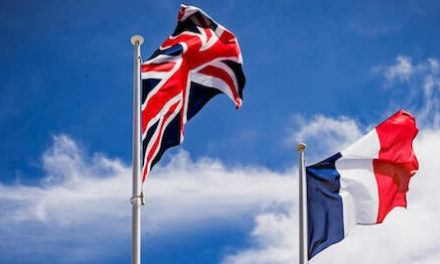Supervised by: Princess Agina MBA (Oxon). Princess studied Business (including Finance, M&A, and Economics) at the University of Oxford. She is a Fulbright Scholar, Laidlaw Scholar, and Oxford Saïd Scholar. She currently runs an AI startup in London.
Abstract
Climate Change has emerged as one of the most pressing socio economic issues facing the 21st century, demanding innovative approaches to drive widespread behavioural change. NGOs are a driving force in catalysing tangible change, and are the bridge between the public and the government. This paper aims to explore how behavioural insights are critically woven into ENGO marketing campaigns in the United Kingdom, exploring the economic outcomes of persuasion techniques, message framing and customer segmentation and the strategies that drive environmentally conscious decision making. In addition to that, this research paper will analyse the role of behavioural economics in marketing campaigns of ENGOs in the UK through comparing and contrasting behavioural techniques such as social proof, nudging, choice architecture and emotional appeal, while also analysing the effectiveness of their use in specific marketing campaigns. Furthermore, the research paper will suggest recommended measures that can be taken by environmental NGOs throughout the world to effectively integrate behavioural insights into marketing campaigns on climate change, hence driving quantifiable change.
Introduction
Climate change poses a real threat to the citizens of the United kingdom. The UK has consistently ranked in the top 20 countries with the most gross carbon emissions per capita, primarily due to its high GDP and per head income which enables consumers to purchase a huge amount of goods and services. Climate induced disasters such as heatwaves in 2019 have already resulted in over 2,556 deaths, while also posing significant public health hazards.
Furthermore, flooding has exponentially affected the UK in a negative manner with over 5 million properties damaged and if this continues, it is expected that there would be a £1 billion per year hindrance to the economy by 2035. Climate change also exacerbates catastrophic weather events, destroying critical infrastructure and aggravating social inequality. This alarming data highlighted the need for immediate action, and emphasised the need for the UK to reduce emissions and strengthen resilience in the face of growing climate consequences.
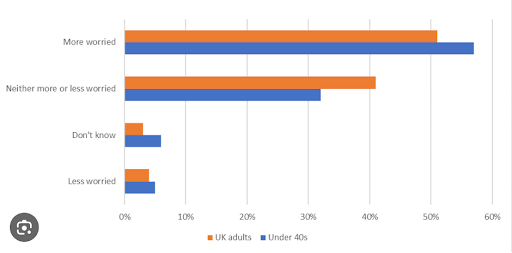
The chart above shows that over 50% of UK citizens are more worried about climate change in 2023 than they were about 10 years ago, depicting a drastic increase in awareness towards the issue. This can be attributed to the success of NGOs and movements like The Climate Coalition, which have played a pivotal role in raising awareness about the menacing threat of climate change and its potential ramifications on society and the macro economy.
Public interest around environmental issues has also dramatically increased over the years, with a quarter of Britons viewing it as the most important issue facing Britain as of 23 August 2023. Against a backdrop of progressive government decarbonisation and net-zero policies, influencing consumer behaviour and social movements through behavioural insights offers a pathway to a more sustainable economy. Understanding that the consumer is not always rational, and often influenced by psychological, emotional and social factors is crucial in the mission of NGOs to inspire substantial eco-friendly changes in consumer behaviour.
The Climate Coalition NGO: Market Segmentation
Market segmentation is the process of aggregating prospective customers into groups that share common needs and have a tendency to respond similarly to a marketing action. It is an effective tool for businesses and NGOs to target varied categories of consumers who perceive the full value of certain products and services differently from one another. Consumers can be segmented in several ways such as demographically, geographically, physiologically, or behaviourally.
Psychological segmentation is a meticulous form of audience identification based on data points such as beliefs, attitudes, interests, and social class. It fosters personalised marketing which creates deeper customer loyalty and allows them to identify with an NGO’s brand in turn becoming an advocate for their needs. Psychological segmentation also bestows NGOs with an opportunity to enhance their marketing message by creating a personalised marketing campaign directed towards a specific target group. This can also lead to the indirect effect of causing better consumer experiences with the NGO.
The Climate Coalition is the UK’s largest group of people dedicated to taking action on the climate and nature crises to avert future climate calamities. Through their ‘Show the Love’ campaign in 2019 in which over 1000 events took place across the UK and thousands pledged to reduce their carbon footprint, The Climate Coalition were able to get their petition, for a net zero target, granted by then UK Prime Minister Theresa May who announced a legally binded target to reach net zero emissions by 2050. They have also amassed 12,000 British citizens for their “The Time is Now’ campaign which became the biggest ever mass lobby in the world for climate, nature, and people.
Not only is this NGO hosting environmental campaigns for net zero emissions but it is also striving for the assurance that public spending and private finances are invested into projects which help cut pollution and protect nature in order to put an end to investments toward fossil-fuel projects that drive climate change. They have prompted the UK Infrastructure Bank to ensure that all of its investments adhere to the 2022 Green Finance Strategy and are net zero aligned to create sustainable infrastructure and jobs across the whole of the UK, as well as supporting UK targets on nature and biodiversity conservation. The Climate Coalition have also discouraged banks such as HSBC, Barclays, Santander, Natwest, and Lloyds who have together funnelled a staggering $368 billion into the fossil fuel industry between 2016 and 2021.
Their vision is to provide a world “where children walk to school breathing fresh air instead of dangerous fumes, and where their parents think about the future with hope instead of fear”. In order to achieve this, The Climate Coalition have adapted the “Six Americas” segmentation in order make their campaigns more appealing to a wider audience by tailoring each campaign with an underlying message that is suitable to one of the six segments of Six Americas.
Global Warming’s Six Americas is a form of psychological segmentation where Americans are fractionated into groups based on their global warming beliefs, behaviours, interest levels, and policy preferences. It was conducted by the Yale Program on Climate Change Communication and the George Mason University Center for Climate Change where data was collected twice yearly from April 2012 and December 2022 as shown by the results in the diagram (Figure 1).
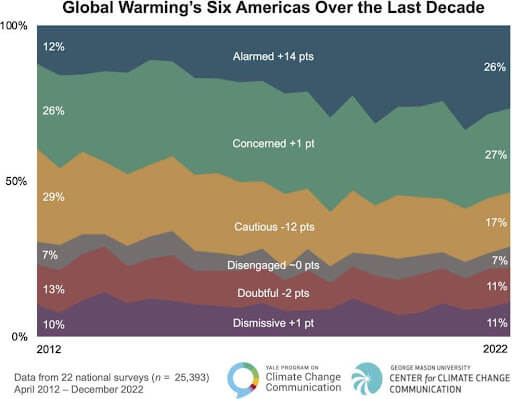
(The average margin of error for each wave is +/- 3 percentage points at the 95% confidence levels and the percentage points are rounded to the nearest whole number due to tabulation purposes in which the total figures might be slightly higher or lower than 100%.)
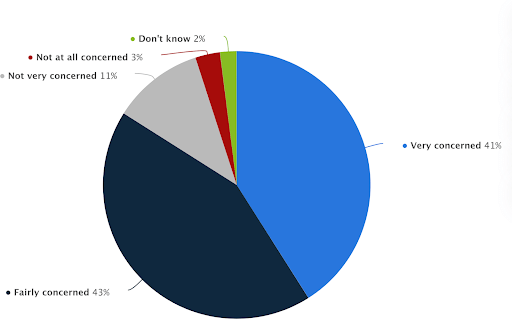
(According to a survey conducted by Statista from 24 February 2022 to 24 March 2022 which showcases the overall concern about climate change in the United Kingdom. There were 4,375 respondents that were aged 16 and above.)
The Alarmed group (Figure 1 and 2) are the most pressed about global warming, the most personally involved in the situation, and the most motivated to take action. They view themselves as knowledgeable and their mindset is not susceptible to change where they delineate their everlasting support to the federal policies that would reduce greenhouse gas emissions. Comparably, the Concerned group (Figure 1 and 2) is similar to the Alarmed group as they perceive that climate change is a profound issue where action must be taken but the two groups are differentiated by the fact that the Concerned group believe that global warming will not hinder society for another decade. The Climate Coalition launched the “Show The Love” campaign in 2015 for climate change activists and those involved in the Alarmed/Concerned group to showcase their care for environmental conservation and abiding concern for global warming by sharing green hearts on social media platforms. The green heart “is a personal message to the members of parliament in the UK, asking them for a green recovery that tackles the climate crisis and sets the NGO on a path to a world that works for everyone”. By 2018, the ‘Show The Love’ campaign has reached 126 million people of which 100,000 individuals have shared green hearts which resulted in over 220 members of Parliament and Peers signing a cross-party joint letter to then Prime Minister, Theresa May, asking her to implement a zero emissions target by 2050.
The Cautious group (Figure 1 and 2) are agree on the fact that global warming is occurring but they have a mixed opinion on whether it is being caused by human beings. On the other hand, there is the Disengaged group (Figure 1 and 2) who usually respond ‘don’t know’ to the surveys, suggesting a lack of knowledge on whether global warming is occurring and whether it will harm the society. This group has the tendency to have a low socioeconomic status and low education levels. To inform the Disengaged group about the drawbacks of climate change, The Climate Coalition have partnered with ‘Send My Friend to School’ in order to incorporate
educational activities in a school environment that enlighten British children about how climate change is impacting education for children across the world, and to think about how they can use their voices to advocate for a sustainable future.
The Doubtful group (Figure 1 and 2) are unsure whether climate change is occurring, but if it is, they are moderately sure that it is caused by natural changes, whereas the Dismissive group (Figure 1 and 2) abide by the fact that climate change does not exist and they are actively working against policies that reduce greenhouse gas emissions. This group adamantly believes that they are well educated about global warming, and that the idea of climate change formulates disagreements among scientists. Research suggests that messengers who are viewed as having similar values and who use familiar narrative lines are the most apt to be heard by the audiences regardless of the factual information in their messages (Kahan, 2010, Kahan et al. 2011). By using this strategy, The Climate Coalition can suggest that there is a wider sociodemographic and political range of messages on the seriousness of climate change as well as they can present varied socio political views who nevertheless agree in large part on the causes and potential impacts of climate change, which results in an audience member to be more likely to find at least one of the stories personally resonant (Boykoff 2004).
Hence, through segmenting the market based on their awareness and sympathy towards climate change, the climate coalition bolstered its chances for success. This is because segmenting the market based on the awareness towards climate change gave the climate coalition the necessary data required to plan and execute strategies that aim on informing and persuading citizens to take action based on their preexisting levels of knowledge about climate change. The probability of a particular strategy being effective in addressing the issue had increased significantly owing to the fact that the campaign catered to the specific needs, knowledge and seriousness of the individual targeted groups.
In conclusion, the implementation of psychological segmentation through the adaptation of Six Americas has been an integral part of The Climate Coalition’s success in resonating with a staggering 126 million people worldwide and this NGO will further serve as an embodiment of the potential prosperous opportunities that can arise due to successful market segmentation.
The Climate Coalition NGO: Market Segmentation
The “Show The Love” campaign was organised by the climate coalition first in 2015, and has been hosted every February since then. The campaign serves as a celebration of places, people and aspects of life that are at risk due to climate change. The primary aim of the campaign is to mobilise a broad spectrum of individuals to create one of the largest climate movements in the UK. The reason why the campaign is held in February is because Valentine’s day falls in the month, and this campaign is emblematic of the fact that climate change can severely affect people and things that we love. As a result of its creative narrative, legitimate backing and a profound concern of climate change amongst supporters, the campaign has succeeded in garnering hundreds of thousands of participants every year around the UK.
The campaign employs a range of marketing strategies to persuade people to join and participate. This includes engaging and emotive storytelling through various media channels, such as social media, video campaigns, and partnerships with influencers. The use of a recognisable symbol, the green heart, has been a prominent feature, encouraging people to visibly display their commitment to tackling climate change and encouraging others to do the same.
Social proof is a powerful behavioural tool which is strategically harnessed throughout the “Show The Love” campaign , with influencers playing a pivotal role in its success. This psychological phenomenon relies on the idea that people tend to conform to the actions of others, especially when they are unsure about what to do. The campaign effectively
incorporates influencers and taps into the innate human desire to seek social validation and affiliation to increase its reach in the United Kingdom.
Influencers from numerous sectors, including environmental activists, celebrities, and thought leaders, are featured in the campaign, participating in various “Show The Love” initiatives.
Notable personalities such as Emma Thompson, Stephen Fry and David Attenborough share their support for the cause which aids in the establishment of a legitimate and popular connection, boosting the campaign’s impact. For example, when a well-known figure posts a green heart on social media or participates in a climate action, it sends a strong message of endorsement, normalising and encouraging similar behaviours among their followers.
The usage of influencers takes advantage of the psychological principle of informational social influence, in which individuals seek direction from others in uncertain situations. The ambiguity in this situation may stem from the perceived difficulty or unfamiliarity of taking climate action. Influencers serve as lighthouses, signaling that taking part in the “Show The Love” campaign is not only permissible, but also desirable and socially respected. This visibility fosters a sense of shared identity and purpose, driving people to act in accordance with those they admire.
The involvement of Influencers starts a chain reaction through the cascade effect. As their followers see and mimic the encouraged behaviours, a ripple effect arises, exponentially amplifying the campaign’s influence. This amplification is especially effective in the digital era, as social media platforms serve as powerful channels for disseminating social proof.
Each green heart shared or climate action undertaken by an influencer serves as a catalyst for a larger movement.
Additionally, the involvement of influencers in the campaign worked on the principle of mutual benefit. Besides aiding in increasing the popularity and credibility of the campaign and attracting participants through social proof, it also played a vital role in boosting the credibility and enhancing the public image of the influencers associated with it. This is because influencers
that advocate for climate action are perceived as socially and environmentally responsible and an asset for the general community, which further boosts their popularity, authority and sways public perception to their favor. Hence, this campaign benefitted all those involved in it, including the climate coalition NGO, influencers and the environment.
The incorporation of influencers into the “Show the love” campaign not only enhances visibility but strategically exploits the principles of social proof to create a profound psychological impact by normalising climate action and calling for collective community action through motivating individuals to participate in campaigns. Through leveraging influencers, the climate coalition transforms the realm of climate activism from a niche concern to a mainstream movement with a wider scale and larger magnitude of impact, hence harnessing the collective power of social influence for a sustainable and impactful cause. Furthermore, the campaign highlights how hundreds of thousands of people join the movement annually, which creates a sense of belonging and normative behaviour. This leads to a domino effect as people are more likely to engage in activities that they perceive as socially accepted or popular.
The campaign also makes an active use of emotional storytelling as a powerful tool to connect with the audience. Advertisement campaigns of the climate coalition effectively tell compelling stories and foster a personal connection with the cause of climate change, hence making it more likely that individuals internalise and act upon the campaigns message. The effectual use of pathos is ubiquitous throughout all advertisements of the campaign and capitalises on the triggered emotional responses such as empathy, concern and love which is generated as a result of celebrating the places, people and aspects of life that are at risk due to climate change in the UK. Emotional storytelling taps into the affective domain of decision making, hence influencing individuals to act based on their feelings and values rather than their short term self interests.
The campaign employs emotional storytelling by crafting narratives that emphasise the tangible impact of climate change on places and communities. This is because focusing on the impact of a particular incident generates a larger magnitude of emotional discomfort as compared to presenting general statistics and numerical data revolving around the broader issue. Highlighting the impact of rising temperatures on local ecosystems through integrating real life examples into personalised stories of people impacted by these changes will successfully evoke empathy and prompt viewers to connect emotionally with the real world consequences of climate change. Additionally, this campaign goes beyond abstract environmental concerns by featuring personal stories of individuals and communities actively affected by climate change, and those who are actively involved in climate action. This occurs through sharing accounts of people adopting sustainable practices, participating in climate events or making a difference in their localities to play a vital role in humanising the issue. Hence, these personal narratives serve as emotional anchors and inspire others to see themselves as a part of the solution.
This can be further connected to the previous argument of social proof, since when people view others being painted in a positive light for taking action on a specific issue, they are also likely to do the same in order to be respected in society.
Furthermore, the ubiquitous use of multimedia engagement adds another layer to the success of the campaign. The Climate coalition leverages various forms of media, including videos, images and written narratives to diversify its emotional storytelling approach. Videos feature testimonials from individuals affected by climate change and showcase success stories of sustainable initiatives , which further appeals to the pathos of viewers and galvanises them to take instantaneous action.
Through its “Show the Love campaign”, the climate coalition masterfully integrates emotional storytelling techniques into real world climate disasters in the UK to generate a profound impact in the hearts of viewers. Through its specific focus on impactful change, personal stories, cherished moments and visual symbolism, the campaign effectively crafts narratives that emotionally resonate with members of the campaign.
Advertisment Analysis
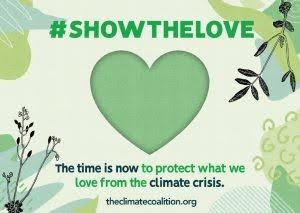
The advertisement above is a perfect example of the depth of the behavioural tools applied by the campaign to attract participants. The colour green is scientifically proven to invoke positivity and optimism within viewers, hence leading them to view climate change as an issue which can be solved and is worth their time. The green heart is emblematic of the fact that we can show love to those surrounding us through protecting them from climate change, which enables the advertisement to capitalise on the pathos of viewers to emotionally persuade them to take action on climate change. The hashtag at the top is a subconscious symbol of social proof since it highlights how this campaign is being appreciated and adopted by several people across social media, which aids in galvanising viewers to jump on the bandwagon themselves from the fear of missing out (FOMO) on a trend.
This advertisement is just one example of how the “Show the love” campaign has effectively utilised social proof, credibility and emotional appeal to attract participants to their campaigns.
Results of the Campaign
The climate coalitions “Show the Love” campaign in the United Kingdom has been a huge success, as evidenced by convincing data and significant participation. Since its establishment in 2015, the campaign has received remarkable participation, with hundreds of thousands of people joining the cause each year which bolsters its legitimacy and scope of impact. These quantitative metrics highlight the campaign’s potential to mobilise a large percentage of the population, demonstrating its resonance and impact on public consciousness.
Furthermore, the campaign’s impact on climate awareness and action in the UK is significant. The campaign leverages emotional storytelling deliberately, utilising themes that appeal with individuals on a personal basis in order to boost the profundity of their impact.
The campaign creates a sense of urgency and connection by highlighting the concrete effects of climate change on beloved locations and communities. The use of visual iconography, such as the green heart, adds to the campaign’s emotional resonance, making climate action a shared, meaningful experience. The campaign was done during Valentine’s Day, which showcased how the things we love are affected by climate change.
The “Show The Love” campaign was a huge success, both in terms of quantitative measurements and qualitative impact on the public and policymakers in the UK. The campaign serves as a paradigm for effective climate activism by effectively mobilising a large number of people, influencing the narrative around climate change through emotional storytelling, and applying pressure on political actions. Its multidimensional approach highlights the power of collective action to affect positive change in the trajectory of climate policy at both the public and political levels.
“Possible” NGO: A Pioneer for Message Framing
Message Framing refers to the strategic presentation of information to change the way consumers perceive and digest information. Specifically in the field of Climate Change, the goal is to put forward information in a way that aligns with consumers beliefs in order to maximise the positive change generated by their reaction. For example, people will be more open to accepting the consequences of meat eating on the environment if the way the message was framed aligned with their pre-existing values. Therefore, this proves how providing “value-congruent” information can be used to help future climate change campaigns.
Many climate change campaigns are framed negatively, which does not align with people’s expectations or values. Fostering shame, eliciting feelings of helplessness and inducing anxiety could have adverse effects. Negative framed messages aim to instil fear, evoke a sense of urgency and generate public concern which can be counter productive and contribute to feelings of eco anxiety. The American Psychology Association defines eco anxiety as “the chronic fear of environmental cataclysm” and suggests it stems from “observing the seemingly irrevocable impact of climate change”. Media consumers are constantly observing climate change campaigns and demonstrations of activism, and these are only likely to increase.
This finding contrasts the theory of the loss aversion bias, which states that consumers and economic agents perceive real or potential loss to be more severe in magnitude than an equivalent gain. For example, the pain of losing $1,000 is perceived to be of a higher magnitude than the joy of gaining $1,000 , which explains why many humans try their best to avoid risk.
However, to a large extent, this bias does not hold true in terms of climate change. This is because positively framed messages that reinstil optimism amongst masses often drive larger impact as compared to negatively framed messages that aim to instil fear of the repercussions of climate change amongst citizens.
Well known campaigns from environmental organisations such as WWF, for example the “Keeping it Cool” 2018 campaign, warn against global warming. Yet the earth warms up and cools down every day, month, year and century, and although potentially driven by human activity, some researchers have contributed to the idea that the term ‘warming’ and ‘global warming’ is a form of elaborate socially constructed propaganda, and controversially, the earth is in fact “boringly healthy”.
We are constantly surrounded by change, a force humans are naturally hard wired to resist yet relaying the effects of climate change inevitably comes with uncertainty, which can undermine the action needed to combat climate change. Sifting through the plethora of climate campaigns and negatively framed titles have contributed to the fact that on average, 64% of the population do not trust politicians, journalists or online influencers to be truthful on the issue.
Here is where the NGO ‘Possible’ shows an excellent and inspiring example on how message framing can be utilised productively to direct and influence change with regards to climate action.
‘Possible’, a well-known non-governmental organisation, focuses on pioneering ways to mitigate climate change and promote sustainable living. It was founded in the United Kingdom in 2006 and actively participates in innovative campaigns and programmes to inspire social action towards a low-carbon, equitable future. To direct positive environmental change, the organisation takes a multifaceted approach across several dimensions that combines lobbying, behavioural science, and community engagement. Its programmes include renewable energy advocacy, sustainable transportation, and community-led projects that enable people to make environmentally good decisions. The NGO actively contributes to the worldwide effort to address the grave challenges posed by climate change by fostering collaboration and community action while using creative methods to do so.
The NGO ‘Possible’ describes its mission as “inspiring people in the UK to take the action the climate crisis demands”. Their platform is filled with positively framed messages that are ubiquitously present, offering hope and optimism for a scintillating future. For example, they state their work “accelerates change by opening new horizons of collective imagination about what’s possible”.
Possible runs ‘yes’ campaigns – ones that foreground the many benefits of taking climate change action rather than focusing on the foreboding doom and gloom. One of their latest projects is introducing “car free cities” and promoting cleaner, greener, safer and more accessible transport alternatives.
A study titled ‘How framing changes responses to uncertainty in climate change communications’ by Morton T showed that uncertainty combined with a negative message frame “decreased individual intentions to act environmentally”. ‘Possible’ successfully presents all their campaigns in a positive manner to bring hope and optimism to an otherwise negative scene of future danger. Therefore they are encouraging individual actions to act “environmentally”, through framing positive messages and portraying the issue of climate change in an optimistic light through highlighting the fact that it is still ‘possible’ to mitigate the impacts of the issue contingent on global cooperation and strategic implementation of a variety of solutions. Hence, they have gained rapid momentum and popularity.
They have gained a mass following and huge media interest – a total reach of 17 million, on broadcasters such as the BBC. Furthermore, the ‘car free cities’ campaign has caused 98% of its pilot participants to plan to permanently reduce their car use. In addition, 5,000 London ULEZ expansion consultation responses from Possible supporters were credited by decision makers for helping secure agreement to rollout.
This shows that all NGOs can take advantage of message framing in their climate missions by portraying climate action as an accessible and achievable part of daily life that all members of society can integrate into their daily lives.
“Climate Outreach” NGO: Choice Architecture
Climate Outreach is an organisation in the UK that specialises in climate change communication and public engagement. Their mission is to ensure that climate change is understood, acknowledged, and acted upon across society. They use various strategies and behavioural insights to effectively communicate the urgency of climate action and drive behavioural change.
They have successfully implemented many campaigns that have a massive impact on the UK, raising awareness and also inspiring actions for climate change. One of the campaigns initiated by them was the “Climate Visuals” campaign. It aimed to enhance public understanding and engagement with climate change by leveraging the power of visual communication. The campaign recognised the influence of choice architecture in shaping perceptions and responses to climate change.
In the “Climate Visuals” campaign, choice architecture was employed through the careful selection and presentation of images related to climate change. Climate Outreach conducted extensive research to identify persuasive techniques that could effectively communicate climate change in a visual manner. They found that certain types of images are more likely to engage audiences and inspire action.
The key finding of the study was that photographs that feature people, particularly diverse individuals or communities are human centric and hence evoke empathy and a sense of personal connection, making the issue more relatable to viewers. It was also found that images portraying a positive outlook on the solutions of climate change are more effective than those that illustrate its negative impacts at length. Hence, depictions of renewable energy sources and sustainable practices assisted in inspiring hope and encouraging viewers to see climate change as a challenge that can be addressed, rather than a calamity which has already done irreversible damage. This key finding can be connected to the previous case study of the ‘Possible’ NGO, and how it used message framing to persuade viewers of the possibility of fixing climate change, and also how ‘The Climate Coalition’ campaign had effectively utilised pathos to deliver emotionally touching and sensational stories.
The study also found that visuals that resonate with the local context of the audience have a far greater impact than those which fit into the more global context. For instance, speaking about local climate issues in a particular community and spreading information about the virulent impacts of climate change in a particular locality, will resonate more with viewers and hence, foster a higher amount of collective action when compared to creating visuals on the global impact of carbon emissions on other nations. This is because showcasing climate related issues specific to a region or community helps individuals connect the global problem to their immediate surroundings, making it more relevant and actionable. This is a classic implementation of the phrase ‘think global, act local’ since it shows how a global issue can be addressed more effectively from a local perspective.
Climate outreach made an active effort to depict authenticity in visual communications. Instead of using illustrated or animated images of climate change harming the planet, the NGO used realistic images that captured genuine moments and authentic emotions rather than overly staged or manipulated visuals generated through computer programs. This helped enhance the credibility and effectiveness of the message, improving support for the ENGO.
Furthermore, the NGO illustrated the impact of climate change on people’s daily lives through connecting it to the occurrence of extreme weather events, changes in landscapes and disruption of communities. Hence, as people noticed the real world consequences in a tangible manner, they were more likely to consider it to be urgent and actionable. Furthermore, the usage of iconic images or symbols used in association to climate change, such as melting ice caps, deforestation and factory emissions proved to be very impactful since it reaffirmed the previous knowledge of viewers with regards to the issue. These symbols have become widely recognised by the global population and conveyed the severity of climate change both, swiftly and effectively. This is because of the instantaneous recall that viewers experience when connected to these symbols or images.
Furthermore, the campaign emphasised the importance of diversity and realism in the images, showcasing a range of people, cultures, and contexts to foster inclusivity and enhance relatability to a broader audience. Moreover, the choice architecture involved framing the images to highlight the human impact and local relevance of climate change, providing context and emphasising real-world consequences, creating a stronger emotional connection, and ultimately encouraging action. Through these well-executed strategies, the “Climate Visuals” campaign successfully communicated the urgency of climate change visually, shaping perceptions, and inspiring viewers to take meaningful actions.
Through these three choice architecture strategies, the “Climate Visuals” campaign effectively communicated climate change visually, influencing public perceptions and engagement. The carefully curated images helped to shape a narrative that focused on positive solutions, human experiences, and local relevance, ultimately guiding viewers towards a deeper understanding of the issue and inspiring them to take action.
Sustainable Futures: Nudge Theory
Nudge theory is a concept in behavioural economics which investigates how tiny interventions, or “nudges,” play a vital role in encouraging individuals to make more positive decisions while preserving their freedom. Nobel laureates Richard Thaler and Cass Sunstein popularised the theory and highlighted the fact that it is based on the assumption that people frequently exhibit predicted irrationalities. Nudges can take several forms, including adjusting default settings, phrasing information differently, and giving social comparisons. The overarching aim of nudge theory is to steer decision-making towards better outcomes, such as healthier lives or greater environmental awareness. Nudge theory has been used in public policy, marketing, and environmental campaigns to encourage desirable decisions while preserving individual autonomy.
Sustainable Futures, a UK-based NGO, leads efforts for a more resilient and environmentally responsible future. The organisation is dedicated to sustainable development and focuses on tackling environmental concerns through innovative solutions. Sustainable Futures has been a driving force in the promotion of renewable energy, biodiversity conservation, and community empowerment since its inception. They actively connect with local communities, businesses, and legislators through joint efforts, promoting a comprehensive approach to sustainability.
Sustainable Futures play a critical role in establishing a more sustainable and equitable future for the UK and abroad by delivering effective projects and advocating for environmentally responsible practices.
The UK NGO ‘Sustainable futures’ also uses nudge theory to help drive action against climate change. Their mission is to “Provide innovative solutions for a changing world”, and they have done many campaigns to help.
The most prominent campaign in which they have leveraged nudge theory was the “Default Option for Renewable Energy”, in which they collaborated with local municipalities to implement a default option for renewable energy. By making renewable energy the default choice for households, they subtly nudged individuals towards sustainable energy sources, which increases the likelihood of people adopting renewable energy without requiring active decision-making.
Sustainable Futures also employs framing techniques to shape perceptions and attitudes towards climate change. Through these strategic communication campaigns, they highlight the positive impacts of sustainable practices and frame them as desirable and socially responsible choices. By strongly emphasising the main benefits of sustainable living, such as cost savings, improved health, and a cleaner environment, they aim to influence individuals’ decision-making by slowly motivating them to take action against climate change. Through integrating positive message framing into their nudge-based strategies, the NGO envisions a future where individuals make sustainable choices effortlessly, contributing to the global efforts to mitigate climate change and create a more sustainable world.
Hence, Sustainable Futures provides a compelling example of how NGOs involved in climate action can effectively leverage nudge theory to galvanise consumers to make choices that ensure the victory of the environment.
Strategic Recommendations to ENGOs in the Field of Climate Change
Environmental NGOs must leverage behavioural economics to enhance the magnitude of results delivered by their climate advocacy. Positively framed messages are powerful tools for shaping perceptions. Instead of emphasising on the negative consequences of climate change, ENGOs must focus on the positive outcomes of sustainable actions and must embrace the possibility of averting the climate crisis through mitigating the impact of climate change.
Additionally, emphasising personal stories of victims affected by climate change rather than relying solely on facts and statistics is essential to create a profound emotional connection, hence, making the climate crisis relatable on an individual level. NGOs should weave compelling stories that resonate with diverse audiences, driving home the urgency of climate action.
Furthermore, climate campaigns must emphasise the connection between climate change and the daily lives of people, through attempting to explain and illustrate how carbon emissions impact weather patterns, rainfall, heat and other environmental factors that humans interact with on a daily basis. This will help citizens connect to the issue first hand through personal experience, enabling them to better grasp its magnitude.
Social proof is another behavioural economics principle which is potent in influencing behaviour. NGOs should showcase successful cases where individuals or communities have embraced sustainability, creating a norm for positive action, hence fostering a sense of collective responsibility. Furthermore, they must integrate influencer marketing into their advocacy strategies in order to increase support for their campaigns as a result of the herd mentality.
Additionally, framing climate change from a local perspective is crucial. Addressing locality-specific issues makes the global problem more tangible and urgent for individuals since they can connect climate change to their community issues.
Choice architecture, referring to the strategic design of decision environments, plays a fundamental role in behavioural economics. NGOs can leverage this tool through structuring choices to promote sustainable behaviours. For instance, ENGOs could design eco-friendly defaults and create easy to follow pathways for green actions to nudge individuals towards environmentally conscious decisions. By strategically designing choice environments, framing information, and leveraging subtle nudges, decision-makers can foster a shift towards sustainable perspectives and actions on both individual and societal levels. Through these interventions, we have the potential to create a more environmentally conscious society and address the pressing challenges of climate change.
Conclusion
This research paper has provided an overview of the behavioural tools and insights which have been triumphantly enacted into UK’s ENGOs, with the intention of reforming campaigns and changing the thinking behind how NGOs can construct their environmental messages in a way which entices a wider audience and fosters the promotion of sustainable actions towards the environment. According to a 2023 survey conducted among UK residents, more than 80% had some concern about climate change. The achievement of this result can greatly be accredited towards the pivotal role of ENGOs in raising awareness about the climate crisis and taking succinct action. This serves as undeniable proof that British NGOs have successfully integrated behavioural economics into their marketing campaigns to drive more change, and can also play a vital role in guiding marketing campaigns initiated by ENGOs throughout the world to raise awareness on global warming and direct climate action more effectively.
References
toolsofchange.com. (n.d.). Tools of Change. [online] Available at: https://toolsofchange.com/en/case-studies/detail/662 [Accessed 25 Nov. 2023].
www.eesi.org. (n.d.). The Japanese Cool Biz Campaign: Increasing Comfort in the Workplace | Article | EESI. [online] Available at: https://eesi.org/articles/view/the-japanese-cool-biz-campaign-increasing-comfort-in-the-workp lace [Accessed 25 Nov. 2023].
Anon, (2019). Choice Architecture Explained: How To Remove Human Bias From Your Business Today | Process Street | Checklist, Workflow and SOP Software. [online] Available at: https://www.process.st/choice-architecture/#history [Accessed 25 Nov. 2023].
www.bi.team. (n.d.). Nudge 2.0. [online] Available at: https://www.bi.team/blogs/nudge-2-0/.
Ridder, D.D., Feitsma, J., Hoven, M.V.D., Kroese, F., Schillemans, T., Verweij, M., Venema, T., Vugts, A. and Vet, E.D. (2020). Simple nudges that are not so easy. Behavioural Public Policy, [online] pp.1–19. doi:https://doi.org/10.1017/bpp.2020.36.
Schubert, C. (2017). Green nudges: Do they work? Are they ethical? Ecological Economics, [online] 132, pp.329–342. doi:https://doi.org/10.1016/j.ecolecon.2016.11.009.
Van Rookhuijzen, M., De Vet, E. and Adriaanse, M.A. (2021). The Effects of Nudges: One-Shot Only? Exploring the Temporal Spillover Effects of a Default Nudge. Frontiers in Psychology, 12. doi:https://doi.org/10.3389/fpsyg.2021.683262.
Sustainable Futures. (n.d.). Partners. [online] Available at: https://sustainablefutures.uk.com/partners/ [Accessed 25 Nov. 2023].
Boykoff, M.T. and Boykoff, J.M. (2004). Balance as bias: global warming and the US prestige press. Global Environmental Change, [online] 14(2), pp.125–136. doi:https://doi.org/10.1016/j.gloenvcha.2003.10.001.
Fleetwood, D. (2018). Psychographic Segmentation: Definition, Variables, Examples and Advantages | QuestionPro. [online] QuestionPro. Available at: https://www.questionpro.com/blog/psychographic-segmentation/.
SearchCustomerExperience. (n.d.). What is Market Segmentation? [online] Available at: https://www.techtarget.com/searchcustomerexperience/definition/market-segmentation Yieldify (2022). 4 Types of Market Segmentation With Real-World Examples. [online] Yieldify. Available at: https://www.yieldify.com/blog/types-of-market-segmentation/.
Leiserowitz, A., Maibach, E., Roser-Renouf, C. and Rosenthal, S. (2018). Global Warming’s Six Americas – Yale Program on Climate Change Communication. [online] Yale Program on Climate Change Communication. Available at: https://climatecommunication.yale.edu/about/projects/global-warmings-six-americas/.
Administrator, H.B.W. (2023). Global Warming’s Six Americas, December 2022. [online] Center for Climate Change Communication. Available at: https://www.climatechangecommunication.org/all/global-warming-six-americas-december-202 2/ [Accessed 26 Nov. 2023].
Leiserowitz, A., Roser-Renouf, C., Marlon, J. and Maibach, E. (2021). Global Warming’s Six Americas: a review and recommendations for climate change communication. Current Opinion in Behavioral Sciences, 42, pp.97–103. doi:https://doi.org/10.1016/j.cobeha.2021.04.007.
The Climate Coalition. (n.d.). The Climate Coalition. [online] Available at: https://www.theclimatecoalition.org.
Jaganmohan, M. (2021). Concern about climate change 2019. [online] Statista. Available at: https://www.statista.com/statistics/426733/united-kingdom-uk-concern-about-climate-change/
Possible. (2023). Be part of the Big Give – the week that doubles your donation. [online] Available at: https://www.wearepossible.org/actions-blog/be-part-of-the-big-give [Accessed 26 Nov. 2023].
Maibach, E., Roser-Renouf, C. and Leiserowitz, A. (n.d.). Global Warming’s Six Americas 2009: An Audience Segmentation Analysis . [online] Research Gate. Available at: https://www.researchgate.net/publication/253113477_Global_Warming%27s_Six_Americas_A n_Audience_Segmentation_Analysis_Invited [Accessed 26 Nov. 2023].
Kahan, D.M., Jenkins-Smith, H. and Braman, D. (2011). Cultural cognition of scientific consensus. Journal of Risk Research, 14(2), pp.147–174. doi:https://doi.org/10.1080/13669877.2010.511246.
Iberdrola (n.d.). Eco-anxiety: the psychological aftermath of the climate crisis. [online] Iberdrola. Available at: https://www.iberdrola.com/social-commitment/what-is-ecoanxiety.
Smith, S.R. and Christie, I. (2021). Knowledge Integration in the Politics and Policy of Rapid Transitions to Net Zero Carbon: A Typology and Mapping Method for Climate Actors in the UK. Sustainability, 13(2), p.662. doi:https://doi.org/10.3390/su13020662.
Majid, A. (2022). Survey suggests people don’t trust the news industry because they don’t understand it. [online] Press Gazette. Available at: https://pressgazette.co.uk/media-audience-and-business-data/trust-in-journalism-news-literacy/
The Climate Coalition. (n.d.). Show The Love. [online] Available at: https://www.theclimatecoalition.org/show-the-love.
Jaganmohan, M. (2021). Concern about climate change 2019. [online] Statista. Available at: https://www.statista.com/statistics/426733/united-kingdom-uk-concern-about-climate-change/
domesticfrugality (2021). #ShowTheLove with green hearts in your window. [online] Sustainable St Albans. Available at: https://sustainablestalbans.org/2021/01/31/showthelove/ [Accessed 26 Nov. 2023]



